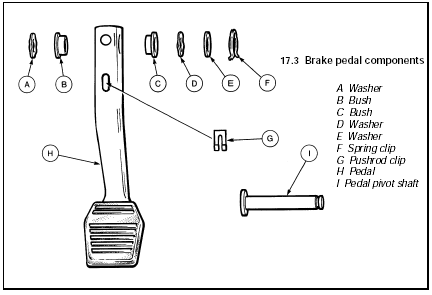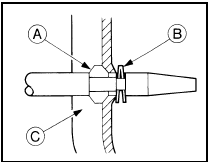Brake pedal - removal, refitting and adjustment
Removal
1 Working within the vehicle, remove the
under-dash cover panel.
2 Extract the spring clip which connects the pushrod to the arm of the brake pedal.
3 Extract the circlip from the end of the pedal pivot shaft and withdraw the shaft with clutch pedal and the flat and wave washers (see illustration).

17.3 Brake pedal components
A Washer
B Bush
C Bush
D Washer
E Washer
F Spring clip
G Pushrod clip
H Pedal
I Pedal pivot shaft
4 Renew the bushes as necessary.
Refitting
5 Reassembly and refitting are reversals of
removal and dismantling. Apply a little grease
to the bushes when installing.
Adjustment
6 Although the braking system may be in
satisfactory condition generally, it is possible
that some drivers may feel that the brake
pedal travel is excessive. The travel can be
reduced in the following way if the upper
surface of the pedal pad is less than 200.0
mm above the metal surface of the floor.
7 Remove the brake pedal as described above.
8 Remove the white plastic bush (see illustration).

17.8 Sectional view of brake pedal and pushrod
A White plastic
bush
B Pushrod clip
C Pedal arm
9 Fit a new bush which is red in colour and will increase the pedal height. Once this type of bush has been fitted it will not be possible to refit the anti-rattle retainer. This does not matter.
10 Adjust the stop-lamp switch (Section 18).
See also:
Windscreen and fixed window glass - removal and refitting
Windscreen
Note: The average DIY mechanic is advised to
leave windscreen removal and refitting to an
expert. For the owner who insists on doing it
himself, the following paragraphs are given.
Rem ...
Air cleaner element renewal (Every 24 000 miles or 2 Years)
Carburettor and Central Fuel
Injection (CFI) models
1 To remove the air cleaner lid undo and
remove the retaining screws or bolts on the
top face of the lid (see illustrations).
34.1a Removing ...
Fuel computer components - removal and refitting
Computer unit
Removal
1 Disconnect the battery negative terminal.
2 Undo the two instrument panel bezel
retaining screws and ease the bezel out to
release the lower clips.
3 Withdraw the compute ...
